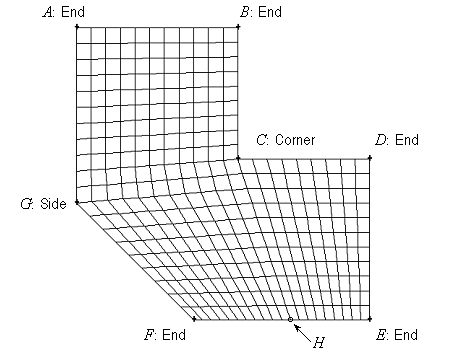To constitute a submappable face, a face must possess only End, Side, Corner, and Reversal vertices. In addition, the total number of End vertices, NE, must satisfy the following equation:
NE = 4 + NC + 2NR
where NC and NR are the total numbers of Corner and Reversal type vertices, respectively, on the face. That is, for every Corner type vertex, the face must possess an additional End vertex, and for every Reversal vertex, the face must possess two additional End vertices.
Note: You cannot specify Reversal vertices. Reversal vertices are used internally by the Meshing application to determine whether the face is mappable.
The shape of the mesh generated by means of the advanced face meshing controls depends on the type and arrangement of vertex types on the face. As an example of the effect of vertex types, consider the face shown in Figure 105: Inside Corner Vertex, which consists of a planar L-shaped face, one corner of which is truncated at an angle.
In Figure 105: Inside Corner Vertex, the inside corner vertex (C) is designated as a Corner vertex, therefore, in order to be submappable, the face must possess five End type vertices (A, B, D, E, and F). The advanced mapped Face Mesh control divides the face into the following two mapped regions:
A, B, C, H, F, G
C, D, E, H
Note: If you enforce an advanced mapped face mesh control on a face, the Meshing application evaluates the face with respect to its vertex type designations. If the vertex types do not meet the criteria outlined above, the Meshing application attempts to change the vertex types so that the face is submappable.
For most submappable faces, there are multiple configurations of vertex types that satisfy the vertex type criteria. Each vertex type configuration results in a unique node pattern for the submapped mesh. When the Meshing application automatically changes vertex types, it attempts to employ the configuration that minimizes distortion in the mesh. To enforce a specific node pattern on a submapped mesh, manually select the vertices such that they meet the advanced mapped mesh control vertex type criteria outlined above. (See Selecting the Vertex Type and Picking Vertices.)



